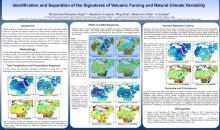Identification and Separation of the Signatures of Volcanic Forcing and Natural Climate Variability
Muhammad Mubashar Ahmad
Dogar
Global Change Impact Studies Centre (GCISC), Ministry of Climate Change, Pakistan
Poster
There is an on-going debate on the volcanic aerosol’s indirect impact that produced strong warming effects over Eurasia and North America in the winter following strong tropical eruptions, such as 1982 El Chichon and 1991 Pinatubo. This volcanic eruption−Eurasian warming has been assumed to be due to post-eruption stratosphere−troposphere interaction that caused strengthening of the stratospheric polar vortex and associated positive phase of North Atlantic Oscillation (NAO). However, recent studies argue that such winter warming may simply be a result of internal variability caused by ongoing positive ENSO (El Niño) events during the eruptions. Nevertheless, some recent studies demonstrated that large volcanic eruptions enhance the probability and strength of El Nino events; hence, volcanic eruptions may still be the initial trigger for the warm winters at high latitudes. No study has hitherto investigated this complex interaction between volcanism and global teleconnections in detail and modeling studies show uncertainties in their findings.
Therefore, further research is highly needed to disentangle the climatic response to volcanic eruptions and improving our understanding of tropical-to-extratropical teleconnections. This research will combine observations and model experiments to better explain the possible cause of post-eruption high-latitude winter warming over North America and Eurasia. In this research, I conducted a set of ad hoc sensitivity experiments with a state-of-the-art coupled climate model, GFDL-CM2.1 to unravel the causes behind the observed post-eruption winter warming and shed light on whether volcanic eruptions can alter teleconnection patterns. In a broad sense, this climate intervention-based research (formerly known as geoengineering) provides a better understanding of the interplay between aerosol, atmospheric circulation changes and teleconnections, laying the groundwork for improved predictions of the global climatic response to natural and anthropogenic changes in aerosol loading.
Therefore, further research is highly needed to disentangle the climatic response to volcanic eruptions and improving our understanding of tropical-to-extratropical teleconnections. This research will combine observations and model experiments to better explain the possible cause of post-eruption high-latitude winter warming over North America and Eurasia. In this research, I conducted a set of ad hoc sensitivity experiments with a state-of-the-art coupled climate model, GFDL-CM2.1 to unravel the causes behind the observed post-eruption winter warming and shed light on whether volcanic eruptions can alter teleconnection patterns. In a broad sense, this climate intervention-based research (formerly known as geoengineering) provides a better understanding of the interplay between aerosol, atmospheric circulation changes and teleconnections, laying the groundwork for improved predictions of the global climatic response to natural and anthropogenic changes in aerosol loading.

Poster file
muhammad-mubashar-dogar-confronting.pdf
(2.33 MB)
